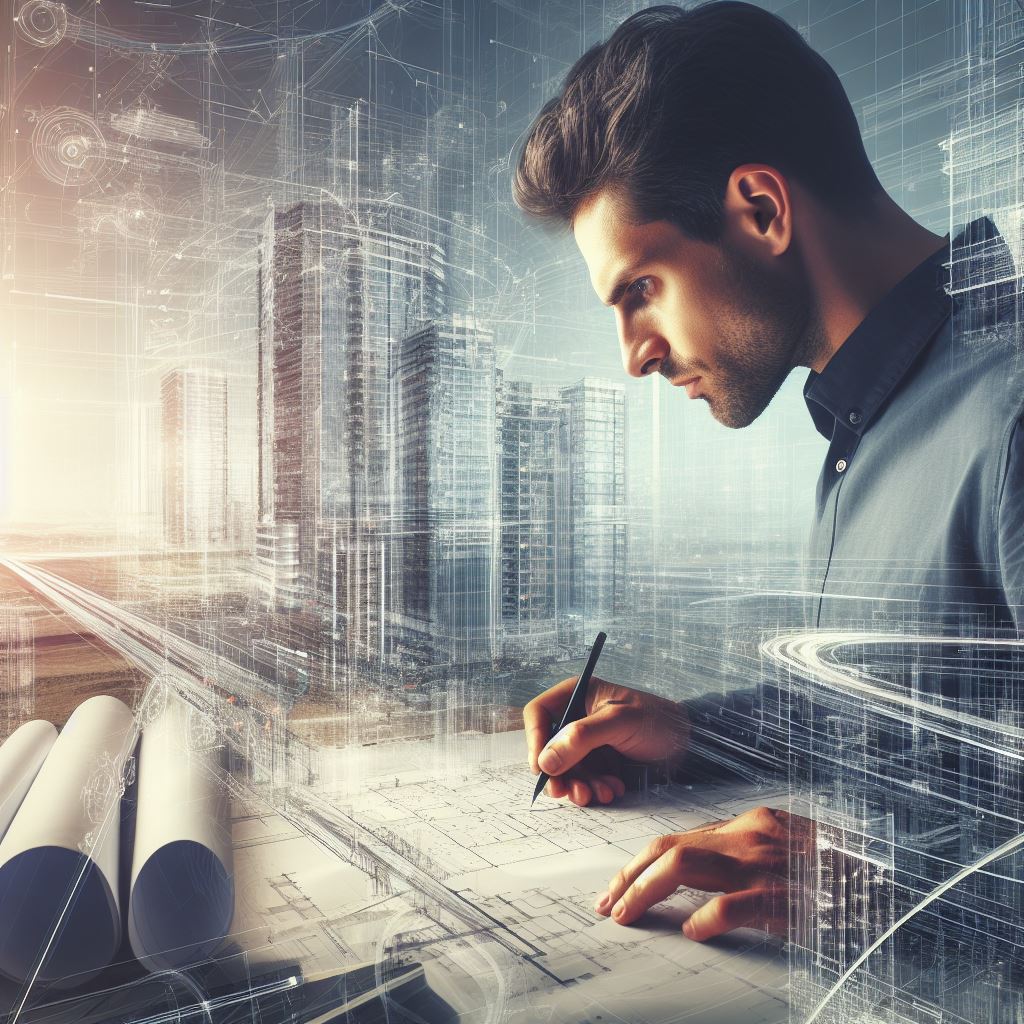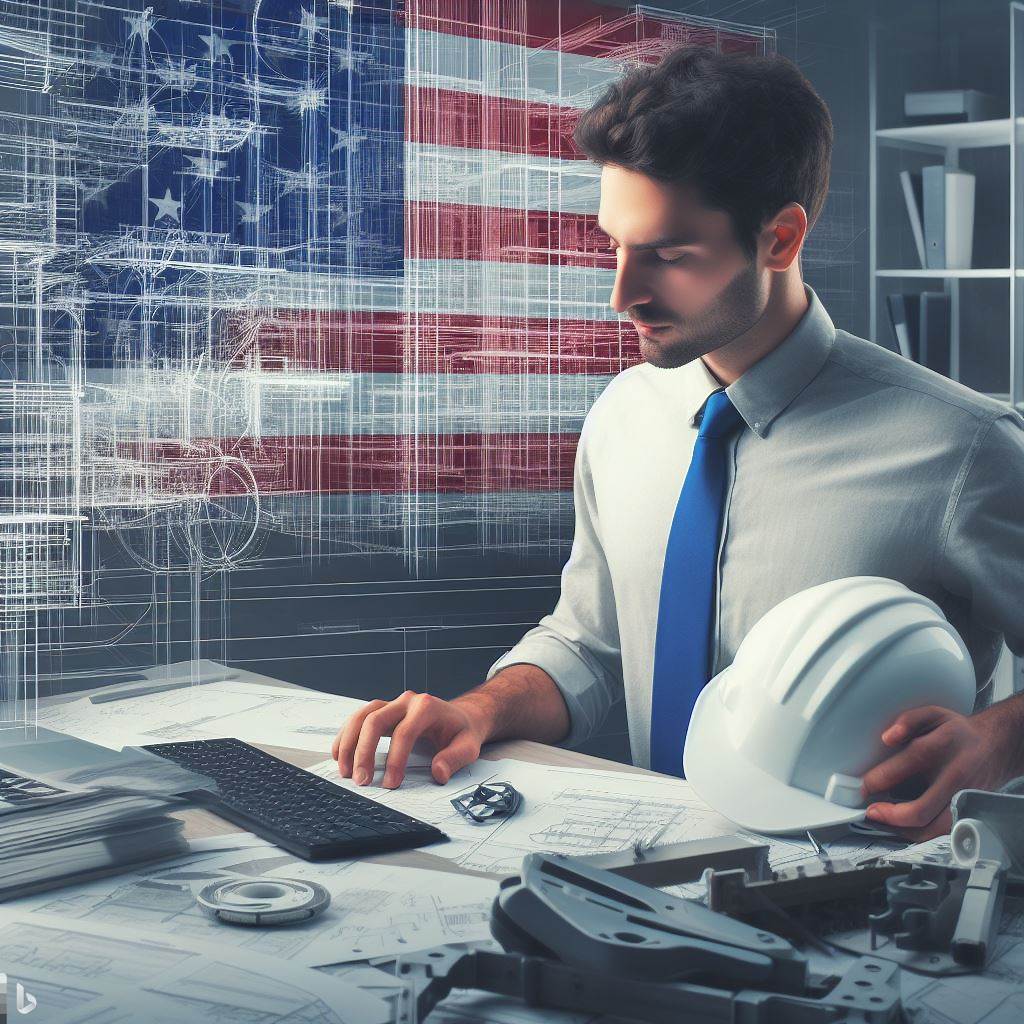Introduction
In today’s modern USA, the fusion of architecture and technology has sparked groundbreaking transformations.
Architects and tech experts collaborate, revolutionizing construction methods and enhancing urban landscapes.
This synergy not only redefines skylines but also shapes our daily lives.
The intersection between architecture and technology in modern USA has reshaped the way we design, construct, and experience buildings.
- Innovative Design: Architects leverage technology to create avant-garde designs, pushing creative boundaries.
- Smart Construction: Advanced construction technologies streamline building processes, ensuring efficiency and precision.
- Sustainable Solutions: Technology aids architects in developing eco-friendly designs, promoting environmental consciousness.
- Immersive Experiences: Virtual reality and augmented reality redefine how users experience architectural spaces, enhancing engagement.
- Urban Connectivity: Tech-integrated buildings contribute to smart cities, fostering connectivity and seamless living experiences.
This section delves into the dynamic intersection of architecture and technology, showcasing its transformative impact on the contemporary American architectural landscape.
The Evolution of Architectural Design
Historical background of architectural styles in the USA
- Colonial architecture introduced European design elements to the American colonies.
- Neoclassical architecture became popular in the late 18th and early 19th centuries, drawing inspiration from ancient Greece and Rome.
- The Gothic Revival movement in the mid-19th century brought about ornate architectural details and pointed arches.
- The Arts and Crafts movement at the turn of the 20th century emphasized craftsmanship and simplicity in design.
- The International Style emerged in the early 20th century, characterized by clean lines and functionalism.
Influence of technological advancements on architectural design
- The invention of steel and concrete allowed for the construction of taller and more innovative structures.
- The use of glass and steel in the 20th century enabled the creation of skyscrapers.
- Advancements in building materials and techniques have allowed for sustainable and energy-efficient designs.
- Digital technology has revolutionized the design process, allowing architects to create complex forms and analyze structures more effectively.
- Building information modeling (BIM) has improved collaboration and communication among architects, engineers, and contractors.
Examples of innovative design concepts and approaches
- The Guggenheim Museum in New York City, designed by Frank Lloyd Wright, showcases an unconventional spiral form.
- The High Line in Manhattan repurposes an abandoned elevated railway into a linear park, integrating nature with urban design.
- The Walt Disney Concert Hall in Los Angeles, designed by Frank Gehry, boasts a unique stainless-steel exterior and acoustically sophisticated interiors.
- The Apple Park in California showcases a futuristic circular design and sustainable features, blending technology with nature.
- The Shanghai Tower in China exemplifies a sustainable skyscraper design, with its double-skin fa‘ade and wind turbines.
Architectural design in the modern USA undergoes a dynamic evolution influenced by:
- Historical Styles: Colonial architecture, neoclassical, Gothic revival, Arts and Crafts, and the International Style.
- Technological Advancements: Steel, concrete, glass, and sustainable practices revolutionize construction methods.
- Innovative Approaches: Architects like Frank Lloyd Wright and Frank Gehry push boundaries with unconventional forms.
Notable projects such as the High Line, Apple Park, and Shanghai Tower exemplify the fusion of:
- Creativity: Architects showcase distinctive designs and unconventional forms.
- Functionality: Innovative concepts integrate nature, sustainability, and cutting-edge technology into architectural masterpieces.
The evolution of architectural design in the United States reflects:
- Human Ingenuity: Constantly pushing boundaries and seeking progress.
- Societal Values: Adapting to reflect values, aspirations, and technological advancements of each era.
The intersection of architecture and technology continues to shape the built environment, creating inspiring and innovative spaces.
Read: Essential Skills and Tools for Modern Mechanical Engineers
Technological Advancements in Construction
The role of technology in construction processes
- Automation and robotics have revolutionized construction, increasing efficiency and reducing labor-intensive tasks.
- Construction management software enables better planning, scheduling, and resource allocation, leading to cost and time savings.
- Building Information Modeling (BIM) allows architects, engineers, and contractors to collaborate seamlessly, improving project coordination.
- Virtual Reality (VR) technology facilitates immersive design experiences and virtual walkthroughs, aiding in design decision-making.
- Augmented Reality (AR) is employed for on-site visualization, assisting in resolving construction conflicts and ensuring accuracy.
Introduction of modern construction materials and techniques
- Use of high-performance concrete with advanced admixtures enhances durability and structural strength of buildings.
- Green building materials such as recycled steel, bamboo, and solar-reflective coatings reduce environmental impact.
- Prefabrication and modular construction methods offer faster project delivery, reduced construction waste, and improved quality control.
- Nanotechnology integration enhances materials’ properties, providing self-cleaning surfaces, increased energy efficiency, and stronger structures.
- 3D printing allows for the creation of complex architectural components, reducing labor costs and enabling design flexibility.
Case studies of technologically advanced buildings in the USA
- Hudson Yards in New York City showcases advanced construction techniques and innovative building design.
- The Gehry Residence in Santa Monica demonstrates the use of digital modeling and computer-aided fabrication.
- The Broad Museum in Los Angeles utilizes advanced seismic technology and energy-efficient systems.
- Apple’s Apple Park in Cupertino incorporates sustainable features like solar panels and natural ventilation systems.
- The Vessel at Hudson Yards is a remarkable architectural structure made possible through advanced engineering and construction methods.
With advancing technology, the construction industry in the USA is continuously evolving and embracing innovative solutions.
The integration of technology in construction processes has led to increased efficiency, improved sustainability, and enhanced architectural possibilities.
From automation and robotics to BIM and VR, technology plays a crucial role in streamlining construction activities and ensuring successful project delivery.
Builders now have access to modern construction materials and techniques that reduce environmental impact and offer faster construction timelines.
Real-life examples of technologically advanced buildings in the USA showcase the potential of these advancements.
From Hudson Yards to Apple Park, these structures embody the marriage of architecture and technology, pushing boundaries and setting new industry standards.
As we move forward, it is essential for architects, engineers, and construction professionals to stay updated on the latest technological advancements.
Embracing these advancements will not only improve construction processes but also contribute to a sustainable and innovative built environment.
Read: A Day in the Life of a U.S. Mechanical Engineer
Smart Buildings and Sustainable Design
Integration of technology to create smart buildings
Incorporating cutting-edge technology in architectural design has revolutionized the concept of smart buildings.
Sensors, Artificial Intelligence (AI), and Internet of Things (IoT) devices are utilized to enhance efficiency and functionality.
Smart buildings use automated systems for heating, ventilation, lighting, and security, resulting in optimized resource usage.
Intelligent control systems allow occupants to monitor and regulate building operations in real-time, promoting comfort and convenience.
Through interconnected networks, smart buildings enable seamless interaction between devices, providing a holistic living experience.
Energy-efficient and sustainable architectural practices
In response to increasing concerns about environmental impact, architects prioritize energy-efficient and sustainable design practices.
Green building materials, such as recycled materials and eco-friendly insulation, are utilized to reduce carbon footprint.
Passive design strategies, such as orientation, natural ventilation, and daylight maximization, minimize reliance on mechanical systems.
Integration of renewable energy sources like solar panels and wind turbines further promotes sustainable energy consumption.
Water conservation measures, such as rainwater harvesting and efficient plumbing systems, play a crucial role in sustainable architecture.
Benefits of smart buildings and sustainable design in the USA
Smart buildings and sustainable design practices offer numerous benefits for both individuals and society in the USA.
Energy-efficient structures result in reduced utility bills for building owners and occupants, aligning with sustainability goals.
Improved indoor air quality in smart buildings enhances occupant health, productivity, and overall well-being.
Optimized resource usage directly contributes to lowering greenhouse gas emissions and mitigating climate change effects.
Smart systems enable predictive maintenance, minimizing downtime and increasing the lifespan of building components.
Investing in sustainable design attracts environmentally conscious tenants, bolstering the competitiveness of real estate properties.
Read: The Future of Mechanical Engineering in the U.S.

Impact of Visualization and Virtual Reality
Use of virtual reality in architectural design and planning
- Architects are increasingly turning to virtual reality (VR) technology to aid in design and planning.
- VR allows architects to create immersive experiences, enabling them to visualize spaces before they are built.
- By using VR, architects can walk through virtual buildings, test different materials, and experiment with lighting.
- This technology helps architects identify design flaws and make necessary adjustments early in the process.
- VR also allows clients to see and experience their future space, providing a better understanding of the final product.
Advantages of 3D modeling and visualization in the USA
- 3D modeling and visualization offer numerous advantages for architectural projects in the USA.
- Accurate and detailed 3D models help architects communicate their ideas effectively to clients and stakeholders.
- Visualization tools enable architects to showcase the aesthetic and functional aspects of their designs.
- 3D modeling allows architects to easily make changes and incorporate client feedback, saving time and resources.
- These tools also facilitate collaboration among architects, engineers, and contractors throughout the project.
Enhancing the client experience through virtual reality
- Virtual reality is revolutionizing the way clients experience architectural designs in the USA.
- VR allows clients to have a realistic understanding of the space they will inhabit.
- Clients can explore the virtual environment, interact with objects, and get a sense of the scale and proportions.
- VR enhances the client-architect collaboration, as both parties can discuss and make decisions based on shared experiences.
- Clients can provide feedback on design elements, leading to better satisfaction and a more customized final product.
In the modern USA, the impact of visualization and virtual reality in architecture cannot be underestimated.
Through the use of VR technology, architects can bring their designs to life, identify flaws, and improve the overall quality of their projects.
The advantages of 3D modeling and visualization tools enable architects to effectively communicate with clients and stakeholders.
Moreover, the immersive experience provided by virtual reality enhances the client’s understanding and involvement in the design process.
With the continuous advancements in technology, the intersection of architecture and tech in the USA will continue to shape the future of the industry.
Read: Mechanical Engineer Licensing: Steps and Requirements in the U.S.
Explore Further: How to Transition to a Telecommunications Technician Career
Transform Your Career Today
Unlock a personalized career strategy that drives real results. Get tailored advice and a roadmap designed just for you.
Start NowThe Future of Architecture and Tech
Emerging technologies and their potential impact on architecture
- Virtual reality (VR) and augmented reality (AR) can enhance the design and visualization process.
- Building Information Modeling (BIM) allows for efficient collaboration and data management in architectural projects.
- 3D printing enables the creation of complex structures with less waste and faster construction time.
- Artificial intelligence (AI) can assist in generating design options and optimizing building performance.
- Internet of Things (IoT) integration can create smart buildings with enhanced functionality and energy efficiency.
Sustainable and eco-friendly innovations in architectural practices
- Green roofs and living walls can provide insulation, stormwater management, and improved air quality.
- Solar panels and other renewable energy systems can power buildings and reduce reliance on fossil fuels.
- Passive design strategies, such as natural ventilation and daylighting, can minimize energy consumption.
- Use of recycled and environmentally friendly materials can reduce the carbon footprint of construction.
- Water conservation measures, like rainwater harvesting and graywater recycling, can promote sustainability.
Predictions for the future of architecture and technology in the USA
- Integration of AI and machine learning will revolutionize the design process, optimizing efficiency and functionality.
- Building automation systems will become more prevalent, allowing for remote monitoring and control of various building functions.
- The concept of smart cities will advance, focusing on connectivity, sustainability, and data-driven urban planning.
- Advancements in robotics will lead to automation in construction, improving safety and productivity.
- Virtual and augmented reality will be widely adopted as tools for architectural visualization and client presentations.
- Renewable energy systems will become increasingly integrated into architectural designs as sustainability takes precedence.
- The use of innovative materials, such as self-healing concrete and transparent solar panels, will become more common.
- Architects will prioritize designing spaces that promote wellness and enhance the occupants’ physical and mental health.
- There will be a stronger emphasis on adaptive reuse and retrofitting of existing buildings to promote sustainability.
- The role of architects will evolve, requiring interdisciplinary collaboration and a deeper understanding of technology.
As the future unfolds, the intersection of architecture and technology in the USA holds immense potential.
Emerging technologies, like virtual reality and 3D printing, will revolutionize the design and construction process.
Building practices will prioritize sustainability, incorporating eco-friendly innovations such as green roofs and renewable energy systems.
The future of architecture and technology in the USA will witness the birth of smart cities and advancements in robotics and automation.
Virtual and augmented reality will become standard tools, aiding architects in visualization and presentation. Innovation will extend to materials and design, with a focus on wellness and adaptive reuse.
Architects will play a vital role, embracing technology and interdisciplinary collaboration.
With these predictions, the future of architecture and tech in the USA looks promising and exciting.
See Related Content: Freelance vs. Firm: Career Paths for US Architects
Conclusion
Recap of the intersection between architecture and technology
Throughout the modern USA, architecture and technology have become increasingly intertwined.
Architects now depend on various technologies to design, create, and construct buildings.
The transformative power of technology in modern USA
Technology has revolutionized every aspect of architecture, from the design process to the construction methods.
It has allowed for more innovative and sustainable building practices.
Closing thoughts on the future possibilities and challenges
Looking ahead, the future holds immense possibilities for architecture and technology.
Advancements like augmented reality and artificial intelligence will further reshape the industry.
However, challenges such as data security and ethical implications of technology need to be addressed to ensure a positive future.
In essence, the intersection between architecture and technology in the modern USA has brought about tremendous changes.
Technology has empowered architects to envision and construct buildings in ways previously unimaginable.
As we move forward, the continued collaboration between architecture and technology holds great promise for the future of the built environment.
However, it is crucial to navigate the challenges that arise and ensure responsible and ethical use of technology in the architectural realm.




